by Derek Swallow
”So what do you do for a living?” I’m asked. “I work as a museum collections registrar.” I reply, gazing on the now blank look of the asker. I continue, briefly describing my job duties: registering potential acquisitions, tracking the process through to the collections committee and ultimate accessioning. This usually draws the ego crippling words: “That sounds interesting” said in that particular pitch that translates to “what a deadly boring job.”
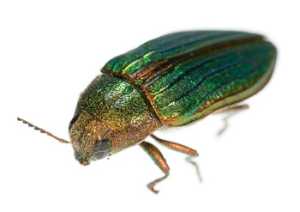
The Beautiful: Buprestis aurulenta – The Golden Buprestid. (Interesting fact – the larvae feed on the wood of recently dead or dying trees and may take more than 60 years to mature if the wood is very dry. (From the Entomology Collection – Royal BC Museum)
Barely controlling my irritation I refrain from spitting out the words: “I love my job. It’s really interesting. You really know nothing about it. So what the heck do you do that’s so wonderful – are you an astronaut or something?” Instead I take a deep breath, smile amiably and prepare for my crushing blow.
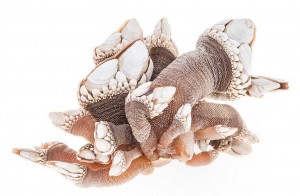
Bizarre: Goose-neck Barnacle (Pollicipenes polymerus) Stalked barnacles that grow in clusters or colonies along exposed shores of the BC Coast) (From the Invertebrate Collection – Royal BC Museum)
Turning slightly away, to show mild indifference, I softly roll out these charged words: “And I manage multi-million dollar loans, sending our priceless museum artefacts to exhibits around the globe.” A brief silence follows, the listener’s head turns, the facial expression transformed to one of amazement, then the response: “What a fascinating and important job you have!” The words “Got ya” drift through my mind. Then, I’m peppered with questions about these awe-inspiring loans. Fair enough, loans do have a certain cache. However, in reality they provoke a huge amount of very unromantic work, often have nearly unattainable time lines and can drive a teetotaler to the nearest pub.
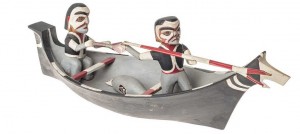
Ethnologically enlightening: Kwakwaka’wakw model sealing canoe (early 20th century) (From the Ethnology Collection – Royal BC Museum #14097 a, b)
I’m not saying I don’t enjoy loans work – I really do. But our acquisition work is underrated as an interesting component of our job. Without doubt, the process has mechanical aspects but few jobs in a museum open access to information spanning the entire spectrum of the collections. I’m privileged to know exactly what enters these collections, on a monthly basis, whether it augments our archival, modern history, ethnological or natural history holdings and how these records, objects, or specimens demonstrate relevance to the human and natural history of our province: intellectual candy for a life-long learner like myself. It’s a pleasure to play my small role in the acquisition of some notable objects – from the historically stellar, to ethnologically enlightening, to the bizarre and the beautiful.
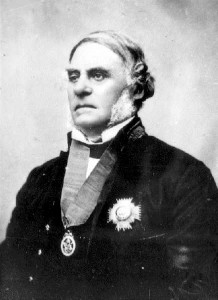
Sir James Douglas – A-01229 (from the BC Archives Collection – Royal BC Museum
Most often a registrar’s participation begins after a collection enters the door of the museum. A few years ago I had the good fortunate to assist one of our history curators retrieve the Douglas chair (see image) and other components of the Douglas collection; the curator needed an extra pair of hands considering the size of some of the objects. The donor was a relative of Sir James Douglas, a renowned historical political figure in British Columbia. Douglas founded the fur trade post Fort Victoria In the mid-19th century then later led the small population of European settlers when this west coast region attained British colonial status. During Douglas’ retirement, in 1871, the colony joined Canada as the 6th province: British Columbia. Not long after the union he suffered a heart attack. In 1877, Douglas died in his residence while seated at his chair.The chair remained a utilitarian object in the family.
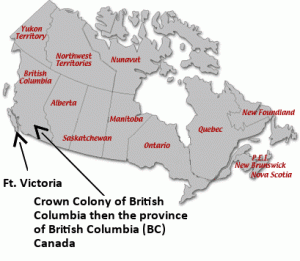
With original fabric worn out, the chair was reupholstered in the 1960/70s using a popular colour fabric and colour from that period – Danish Modern orange. Sir James Douglas, despite his auspicious career and elevated rank, was a practical man. I’m sure he would have approved of extending the service of the chair to over 140 years through such refurbishment.
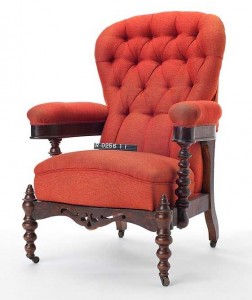
Historically Stellar – Douglas Chair – C1870 – Victorian Parlour Chair – History Collection – Royal BC Museum
For curators, collections managers and registrars the restored chair provokes an interesting question. Is it still authentic? To be authentic and worthy of museum collection must an object retain its original appearance or does it suffice that it need only retain its original function and association? In this case, it is still a chair, the very chair where James Douglas died whether it has original upholstery or not. Reviewing our museum’s collection policy, which guides what we do and do not collect, the Douglas chair fits into our collecting parameters: it has historical significance to the province of British Columbia, clear provenance, and meshes with our requirement for its “condition or completeness” The policy states: “Objects included in the collections of the RBCM [Royal BC Museum] will be complete, sound, and/or in original condition, where possible.” The phrase “where possible” permits us to collect objects of enormous historical significance, such as the Douglas chair, despite modifications made over time.
I stumbled upon this interesting link which I’d like to share with you. The author muses on the term “authenticity” within the heritage/museums context. She has some very interesting points. http://ejarchaeology.wordpress.com/2013/03/29/my-bike-the-authentic-object-with-its-own-biography/. I look forward to your comments on this subject. I would also be interesting to learn your museum’s particular guidelines regarding “authenticity”.









 With original fabric worn out, the chair was reupholstered in the 1960/70s using a popular colour fabric and colour from that period – Danish Modern orange. Sir James Douglas, despite his auspicious career and elevated rank, was a practical man. I’m sure he would have approved of extending the service of the chair to over 140 years through such refurbishment.
With original fabric worn out, the chair was reupholstered in the 1960/70s using a popular colour fabric and colour from that period – Danish Modern orange. Sir James Douglas, despite his auspicious career and elevated rank, was a practical man. I’m sure he would have approved of extending the service of the chair to over 140 years through such refurbishment.

